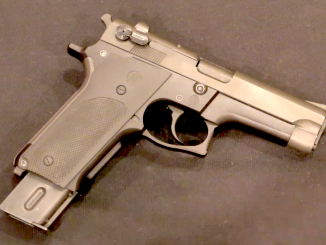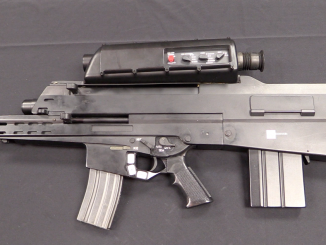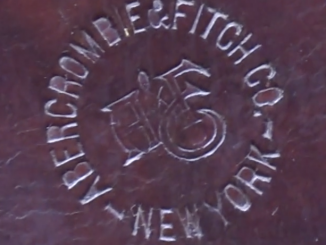This pistol sold for $3,163 at Rock Island in December 2, 2018.
Star entered the Wondernine era in 1978 with their Model 28 pistol, a double action 9mm offering with 15-round magazines. It was one of the entrants in the first round of US military XM-9 trials, but unfortunately for Star was beat out by the Beretta 92. Star took feedback on its gun from the commercial market, and revised a number of small elements to create the Model 30, released in 1981. A few years later (in 1986), the Colt company purchased 20 Stars – 10 30Ms and 10 30PKs – for “internal review” to see if they might be interested in manufacturing the design. They decided not to, and sold the guns off to Colt employees not much later.
A quick designation guide to the Star 28/30/31 series; M indicated a military pattern with a full length slide, P indicates a Police pattern with a shorter slide, and K indicated an aluminum alloy frame instead of the standard steel frame.




Colt made, or imported, a small number of DA automatics in 9mm and .40 S&W around that time. I saw one in a local gunshop about two decades ago, labeled “COLT 40” on the side of the slide; it was in fact a .40 S&W caliber, although it just said “.40 AUTO” on the barrel over the chamber.
The dealer said that there were less than 200 made and Colt decided not to proceed with it. He got it from Ohio Valley, now out of business.
I remember that it had a heavy, rough trigger pull and seemed even clumsier in my hand than a S&W Sigma. Also, that it resembled the Star 30 in overall design.
No, I didn’t buy it.
cheers
eon
“.40 S&W caliber”
According to http://star-firearms.com/firearms/guns/283031/index.shtml there existed Model 31M which was derived from 30 and chambered for .40 S&W cartridge. There were some problem with that particular version.
OK, the Model 31M in .40 looks exactly like what I saw and handled. Apparently Colt imported some with an eye to selling them under their trademark after the Colt M2000 bombed.
Thanks for clearing that up!
cheers
eon
Remember that Star had collaborated with Colt before, the Colt Pony is a Star model D sold under Colt`s name.
I wonder if the “C” at the end of the serial number was applied by Colt or Star? It seems to be not quite lined up with the rest of the digits.
The Star model 30 was an excellent pistol. The 30 PK was for many years the regulation pistol of Spanish National Police (known by the police as Modelo 28 PK) until it was replaced by the HK USP Compact. It was highly popular. The model 30M was used by the Spanish Navy and certain unit of Spanish Gendarmerie (Guardia Civil).
The Army choose the Llama M82 in lieu of the Star, but against technical criteria, the Government opted to give Gabilondo y Cia a part of the cake.
In accordance to what commercial right or rule was Colt Hartford L.L.C able to purchase competing company’s product and put their own name on it?
Let’s imagine Izhevsk weapon factory would buy 20 Smith & Wesson pistols(Colt has nothing of interest in pistols to offer) and put name Kalashnikov on it. Where would that end?
Shame both Star and Astra names disappeared from market. To see homage paid to CZ75 by Star is interesting, they are not the only one.
“CZ75”
http://star-firearms.com/firearms/guns/283031/index.shtml states that
These features, taken as a whole, have led many observers to decide that Stars of this era are all derived from the CZ75. Though I have never been in contact with a Star weapons designer, I believe this to be untrue, and that the Star designs are derived from 1930 Swiss pistols instead.
CZ75 DA trigger construction which thoroughly unique at its time, was
completely borrowed and used in new generation Star pistols. This wipes off that statement
Wait, this might explain why Colt abandon further action.
IIRC Spaniards have special rule (or at least they did in 1920s): IF YOU DON’T PRODUCE YOUR GUN IN SPAIN, YOUR PATENTS HAVE NO POWER HERE. Was still active when Model 30 was introduced? If yes they might ignore any patents covering CZ 75 elements, but if trigger-hammer group (or elements of thereof) were patent in US Patent Office, then Colt might want to avoid patent infringement.
CZ75 was patented only in its own country and this why Italians and some other gun makers easily copied it. AFAIK.
This was true in the 20s but not in the 80s. Spanish patent legislation changed completely at the beginning of that decade to accommodate to the European Common Market (today European Union) rules. In addition, Spanish market wasn’t very important for Colt, not even for Astra, Star and Llama (Spanish legislation is very restrictive). Really, it’s a question of productions costs. Then they are cheaper in Spain than in the USA. Today other makers, for example Springfield, import guns from Brazil where labour costs are minimal.
I see the markings more as a mark of who they belong (“our company bought these, so they are ours”).
It’s not as if they were trying to re-sell them, after all.
Star and Astra (and ASTAR, later) were very thoroughly shafted by the government from mid-80’s onward (when military contracts for Z84 SMGs began suffering “funny things” and political arbitrary decissions), altough some would argue from early 90’s (when the government kept sinking millions in defective parts from government factories instead of fulfilling signed agreements). Not the only companies to suffer that fate, of course.
Also, tweaks to the civilian ownership of firearms making handguns even harder to own, and the “opne market” of the EU, really brought hard times on Spanish firearms industry.
And that’s just from my observations from the outside! What stories would tell some of the insiders at those companies?
Hi José Antonio,
I believe the history of the demise of Star and Astra is still to be written. Many former employees are still alive and it would be easy to interview them. I haven’t ordered yet the two tomes by Leonardo Antaris on Astra and Star firearms and wonder if he covers the final stage in the life of both companies (and ASTAR, for that matter).
Best,
R. Aballe
One of my relatives owned Astra revolver in .357 Mag. It was solid weapon, good fit overall.
I always associated Astra brand with automatic pistol rather than revolvers.
They made various automatic pistol of various sizes, U.S. shooters might know ASTRA CUB and even do not know it is ASTRA as it was marketed in U.S.A. as COLT JUNIOR firing .22 Short cartridge. They also production bigger automatic pistol, to name few: A-60 (WaltherPP-like but with double-stack magazine), A-75 (compact automatic pistol for 9×19 Parabellum and .45 Auto cartridges), A-80 with siblings: http://modernfirearms.net/en/handguns/handguns-en/spain-semi-automatic-pistols/astra-a-80-a-90-a-100-eng/
Regarding revolvers, Llama latest models worth to see. They were made in a different safety mechanism taking the hammer up away the firing pin so called “Trible Lock” as borrowed from old Allen revolvers.
I am assuming that was simply the standard importer stamp that is required for importation.
“Model 28 pistol”
Regarding STAR automatic pistols I might recommend star-firearms site:
http://star-firearms.com/firearms/guns/283031/index.shtml
At the age when CZ75 considered “Best Service Handgun” by most of gun experts but no clear inputs available at reach, Colt handled a very similar model, evaluated and rejected… lnteresting…
“rejected”
This is even more interesting, if you consider that if I am not mistaken at that moment (1986) they did not have competitor to S&W Model 59 and by introducing that one they might have.
Was it this project we talk about?
https://ezine.m1911.org/showthread.php?205-CZ-40B-Review
Colt did not have any contribution on that part of statement of task.
The whole history of Colt semiauto pistols after John Browning’s designs is “interesting”. Their contribution beyond the M1911 has been quite minimal. I don’t know why they didn’t adopt a version or development of the Star 30, but by that time (late 1980s) it probably would have been too late for them to regain a significant foothold in the semi-automatic pistol market in any case. That is, beyond the aforementioned M1911 variants.
“Model 30 does not have a decocker…”. Wrong. Place pistol on safe. Pull trigger. Hammer decocks.
The reason that Colt marked these pistols with their name and address is probably a bit more prosaic. As the importer of the firearms, they were required by federal law to do so, just as Garcia Corp. and Interarms put their markings on the Star pistols that they imported.
Cheers!
Splice
Ahh, that explains it. Thanks.
I had one of these (30PK) as my daily carry in South Africa as well as my backup to my service pistol in the police. I put over 20k rounds through it in the 15 years of ownership. The only ‘repairs’ I made were refinishing and replacement magazine and slide guide springs.
It ate everything I put through it including dodgy reloads. I would love to get another one.
Serví en la Armada, Infantería de Marina finales de los 80 y como poseedor durante ese tiempo de una Star 30M de doble acción puedo decir que a 50 metros en tiro de combate; todos los disparos tiro efectivo del arma en diana con puntuaciones muy altas.
Puntuaciones *